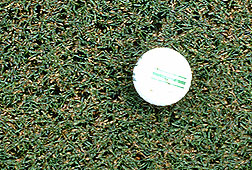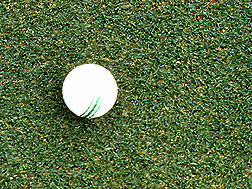Grass Tailored Just for Putting Greens
|
|
TifEagle, a new bermudagrass for putting greens, will debut this summer on golf courses in Florida, Georgia, and other southern states.
It is the latest product of Agricultural Research Service geneticist Wayne W. Hanna's research to develop new forage and turfgrass varieties with improved performance, quality, pest resistance, and other desired traits. An advantage of TifEagle: It crowds out pesky weeds--even at low cutting heights--reducing the need for herbicides that may endanger groundwater.
TifEagle is being licensed to certified seed producers under a collaborative agreement between ARS and the Georgia Seed Development Commission and University of Georgia Research Foundation, both located in Athens. ARS has also applied for a patent. Through licensing, Hanna hopes to preserve the genetic purity and longevity of TifEagle in commercial production.
Groundskeeper Ralph A. Hinz, of The Landings golf club in Savannah, Georgia, is impressed with TifEagle's ability to tolerate the close, daily mowing that gives the North's cool-season bentgrass varieties their putting speed. Unlike many of the South's existing bermuda varieties, including the industry standard Tifdwarf, TifEagle withstands routine cutting to a height of 3 millimeters (one-eighth inch). Most importantly, its leafy canopy stays lush and carpetlike, ensuring a golfer's ball rolls quickly in the direction it's putted.
"You can get Tifdwarf to where it's really fast for special golfing events like the Masters," says Hinz. "But you can't keep it at the same height as a bentgrass for too long before it starts to thin out from stress."
Such stress can open the door to opportunistic algae or to weeds like crabgrass, necessitating use of herbicides. TifEagle's key advantage is its fast growth and tightly knit root system. As a result, "it has a thick canopy to shade out the algae and weeds," says Hanna.
"It's very aggressive, which I feel is a plus," says William F. Smith, a golf superintendent who began testing TifEagle last year at the Country Club of Columbus in Columbus, Georgia. "I look at it as far superior to our existing greens."
To develop TifEagle, Hanna first subjected portions of the bermuda variety Tifway2 to gamma radiation. Then, he selected mutant plants with very short stolons--shoot-like structures that enable a turfgrass to withstand frequent mowing. TifEagle was Hanna's top pick of 48 such mutant plants.
|
|
Test plantings on experimental plots and putting greens since 1991 indicate that it outperforms its predecessor--Tifdwarf--at mowing heights of one-eighth inch or less. Over 3 dozen university scientists and golf superintendents from California to North Carolina participated in these tests.
Currently, the Georgia Seed Development Commission has 12 acres of foundation sprigs, says Earl Elsner, the organization's director. Each acre will produce sprigs for 40 more acres of certified plant material.
Hinz, who helped evaluate TifEagle, plans to establish the new grass this summer on all the putting greens at one of The Landings' six courses. He has already gotten positive feedback from the club's golfing clientele. "They'll ask, 'How come this green puts better than the others on the course?'" says Hinz.
For his part, Smith says, "We'll plant our practice putting green in TifEagle, just to see how it responds to wear and tear." Meanwhile, Hanna is continuing his search for hardy new grasses, especially those with resistance to fungi and insects like the tawny mole cricket.
"We have a philosophy here," he says. "We're going to have to grow grass in the future with less water and less pesticide. So we make sure we don't baby our grasses in the test plots."--By Jan Suszkiw, Agricultural Research Service Information Staff, 6303 Ivy Lane, Greenbelt, Maryland 20770, phone (301) 344-2173.
Wayne W. Hanna is in the USDA-ARS Forage and Turf Grass Research Unit, P.O. Box 748, Tifton, GA 31793; phone (912) 386-3177, fax (912) 391-3701, e-mail
"Grass Tailored Just for Putting Greens" was published in the May 1998 issue of Agricultural Research magazine. Click here to see this issue's table of contents.








